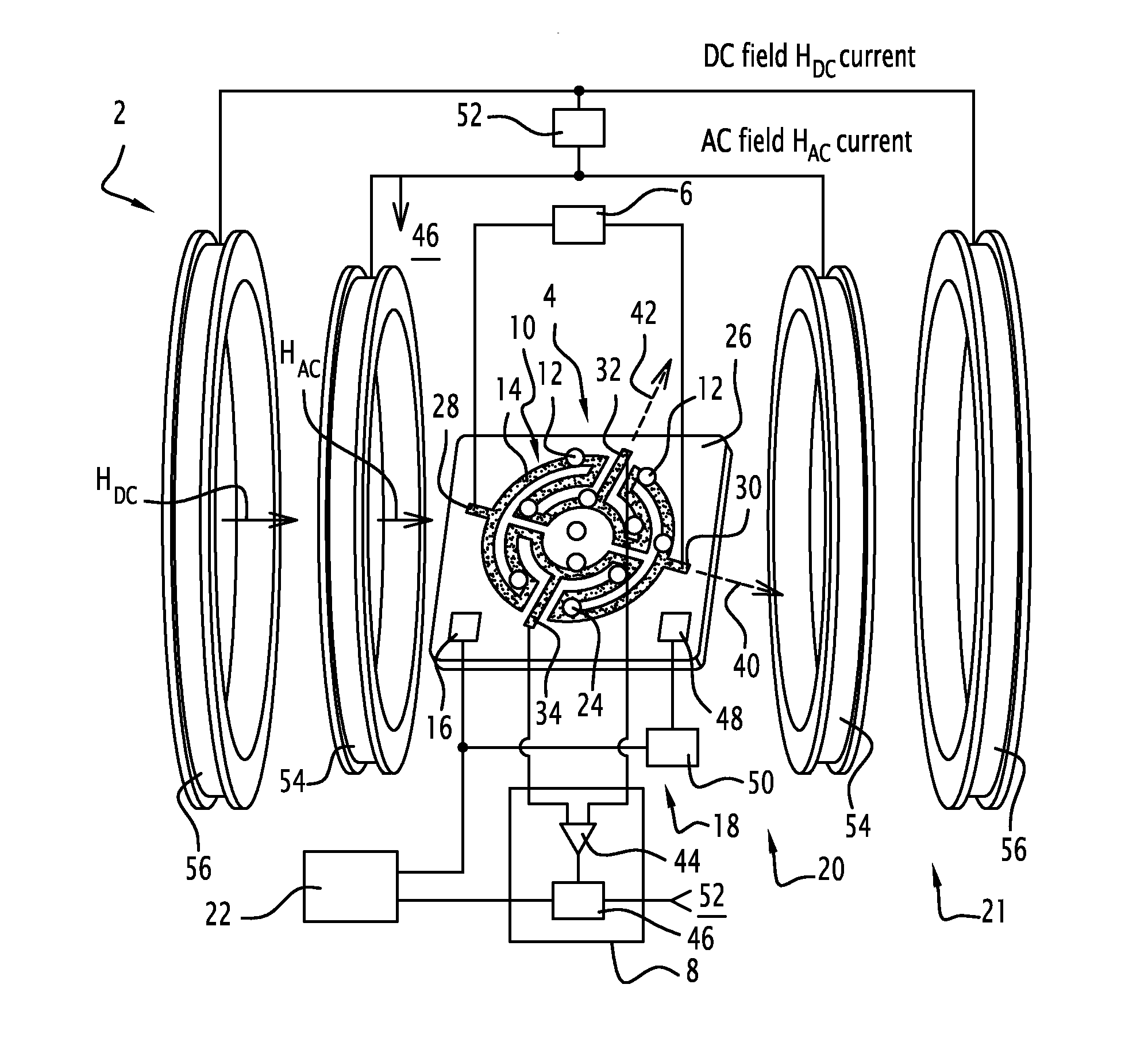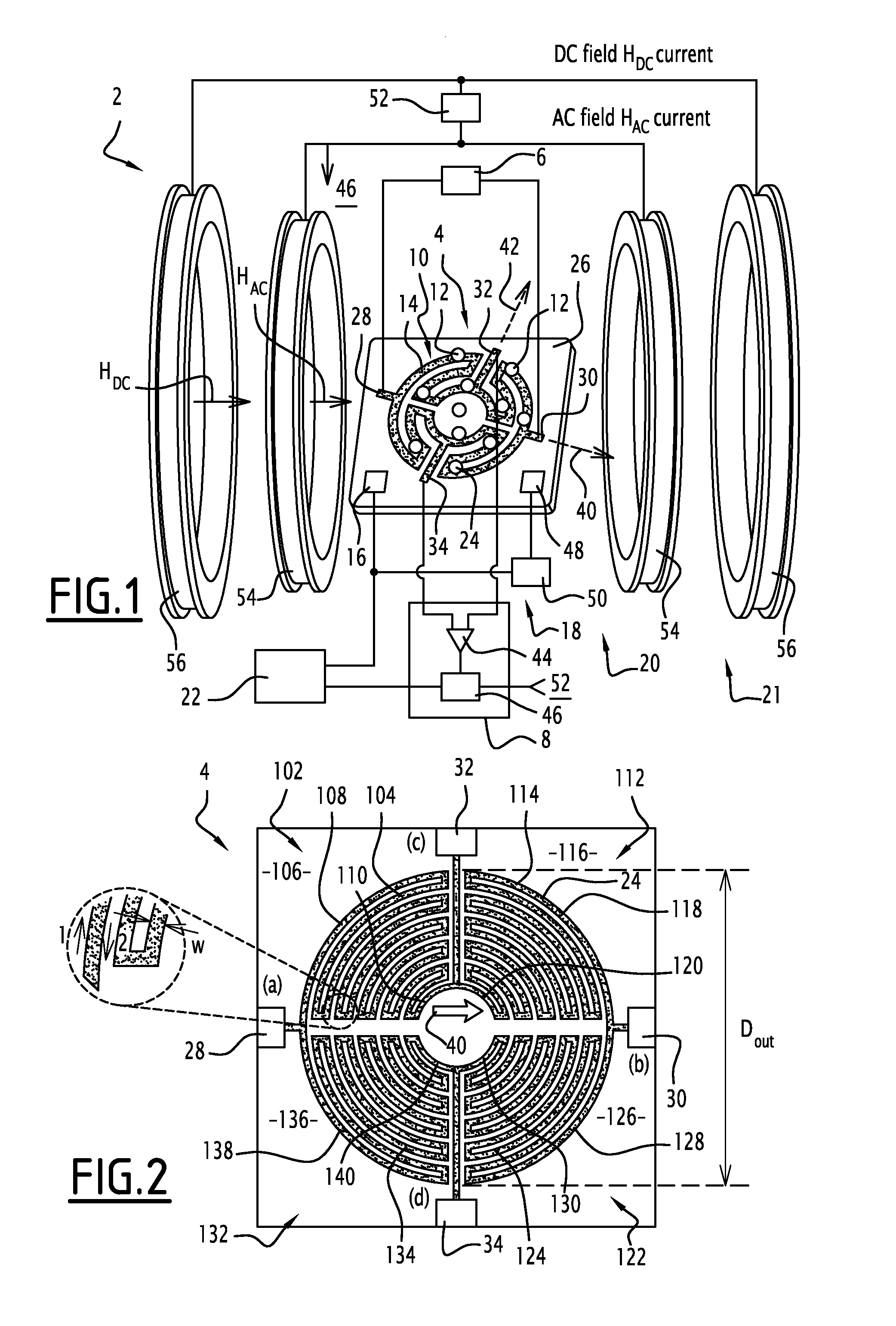Micromagnetometry detection system and method for detecting magnetic signatures of magnetic materials
a magnetic signature and detection system technology, applied in the field of micromagnetometry system, can solve the problems of limited working temperature of such a magnetometry detection system, inability to study the magnetization properties within the room temperature range, and current ultra-sensitive squid detection method
- Summary
- Abstract
- Description
- Claims
- Application Information
AI Technical Summary
Benefits of technology
Problems solved by technology
Method used
Image
Examples
second embodiment
[0222]According to FIG. 6, a micromagnetometry system 302 according to the invention is derived from the micromagnetometry system 2 of FIG. 1 and comprises some parts that are designated by the same reference numerals.
[0223]The micromagnetometry system 320 of FIG. 6 differs from the micromagnetometry system of FIG. 1 in that the means 20 for creating the magnetic excitation field HAC external to the first magnetic sensor 4 are removed and replaced by the set 320 formed by the first magnetic sensor 4 and a modified first current source 326, connected between the first and second current terminals 28, 30.
[0224]In this second embodiment, the modified first current source is configured to generate an alternating current (AC) oscillating along the time at a constant frequency ω ranging from 10 to 3 KHz, here set to 100 Hz.
[0225]By self-induction, the magnetic track 24 of the first magnetic sensor 4 supplied with an alternating current (AC) by the first modified current source 326 generat...
third embodiment
[0234]According to FIG. 7, a micromagnetometry system 402 according to the invention is derived from the micromagnetometry system 2 of FIG. 1 and comprises some parts that are designated by the same reference numerals.
[0235]The micromagnetometry system 402 of FIG. 7 differs from the micromagnetometry system of FIG. 1 in that it comprises further a second hybrid AMR / PHR multi-ring magnetic sensor 404 and in that the first voltage measurement device 8 of FIG. 1 is replaced by a modified voltage measurement device 408.
[0236]The second magnetic sensor 404 has the same structure as the one of the first magnetic sensor and has closed loop magnetic track 424 with the same shape pattern.
[0237]The second magnetic sensor 404 has a first current terminal 428 and a second current terminal 430 forming a pair of current terminals which face each other contacting with the closed loop magnetic track 424.
[0238]The second magnetic sensor 404 has a first voltage terminal 432 and a second voltage termi...
first embodiment
[0251]According to FIG. 8, a micromagnetometry detection method 500 for detecting the presence of very small quantities of magnetic particles is carried out by a micromagnetometry system as defined in the FIGS. 1, 6 and 7.
[0252]This method 500 is applicable to any for magnetic particles that are switchable molecular nanoparticles by overstepping a predetermined switching threshold in terms of a switching physical property that operates as a switching command. Such magnetic particles are any switchable molecular nanoparticles in form of AhBk[M(CN)6]l.mH2O, where A can be Co, Ni, Fe, etc, B and M can be various transition metals (FeII, FeIII, MnII MnIII, fml aCoII, CoIII, . . . ) and C is an alkali metal.
[0253]The micromagnetometry detection method 500 comprises the following steps executed successively.
[0254]In a first step 502, an unknown amount of magnetic particles is deposited upon the first magnetic sensor, the magnetic particles being switchable molecular nanoparticles by overs...
PUM
 Login to View More
Login to View More Abstract
Description
Claims
Application Information
 Login to View More
Login to View More - R&D
- Intellectual Property
- Life Sciences
- Materials
- Tech Scout
- Unparalleled Data Quality
- Higher Quality Content
- 60% Fewer Hallucinations
Browse by: Latest US Patents, China's latest patents, Technical Efficacy Thesaurus, Application Domain, Technology Topic, Popular Technical Reports.
© 2025 PatSnap. All rights reserved.Legal|Privacy policy|Modern Slavery Act Transparency Statement|Sitemap|About US| Contact US: help@patsnap.com



